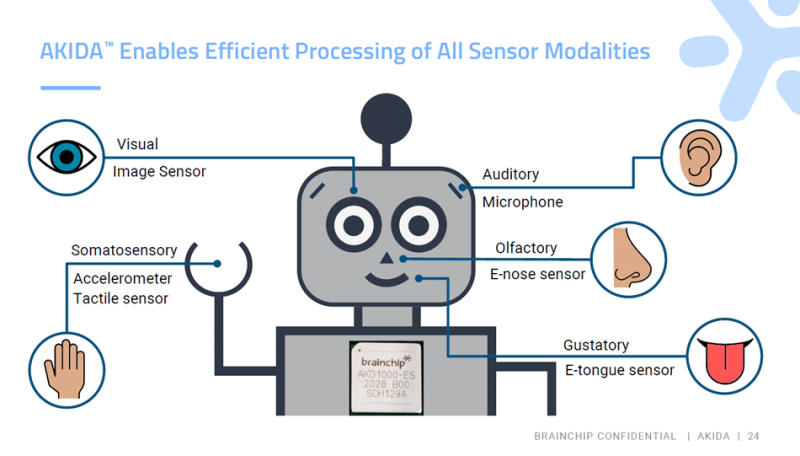This market research report was originally published at Semico Research’s website. It is reprinted here with the permission of Semico Research.
And Where Does BrainChip Fit into the Picture?
Unquestionably, the introduction of augmented Artificial Intelligence (AI) into our economy and society is going to have profound effects on how we engage with the world around us and how we expect the world to engage with us. Many parallels can be drawn between today’s AI innovations and similar past periods in history. In each of these cases, the world experienced great leaps in innovation and invention, which correspondingly produced great improvements in our daily lives.
Perhaps one of the most notable technological introductions was that of the mainframe computer for business and science applications back in the early 1950’s by IBM. This innovation led to the deployment of computing power to many companies throughout the world and allowed even small companies, through time-sharing arrangements, to have access to this capability. The 1950s and 1960s were decades where great leaps in productivity were made, enabled by this and other advancements.
As semiconductor technology continued to advance, it became possible to fractionalize the computing power of the mainframe and allow this compute power to be distributed into new markets and environments. The personal computer was created and its evolution started a solid wave of growth in the world by enabling a whole new range of applications and markets.
Each time a higher performing solution entered the market, it generated ever-higher unit volumes and revenues for both the computer market and the semiconductor market. This could take the form of either smaller footprints, lower cost structures, lower power budgets, higher performance or all four in one package. This resulted in continually increased demand for such systems, as well as new silicon solutions and drove the creation of ‘Hyper-Volume’ applications where the unit shipments started to become measured in billions of units.
There are several comparisons that can be made between the evolution of the PC market and the ongoing development of the AI market. The key difference here is that an extensive ecosystem already exists, compared to the buildout needed at the beginning of the PC era, which will now speed the deployment of AI functions into the market. The current ecosystem will be extended and enhanced further as the new technologies enter and new solutions are created. In addition, robust applications already exist in massive volumes today, with multiple vendors and silicon solutions available for each one. What many of the AI developers are doing today is adding the right level and type of AI functionality to the already existing silicon solutions.
Currently the emphasis is on correctly identifying the right use cases for AI functionality and then demonstrating their value propositions to the prospective users. The solution must provide a tangible benefit to the end user for it to be accepted enthusiastically. In this process the current market leaders, in each application segment, may not necessarily be the same market leaders when their solutions are rolled out tomorrow . Care must be taken by each developer, to ensure that each solution correctly identifies the right market requirements and drivers in order to remain as market leaders. There will still be many winners, but they may be different from the ones we currently have. This opens the door for new entrants that have great ideas.
The AI Market Functionality Landscape Today and Tomorrow
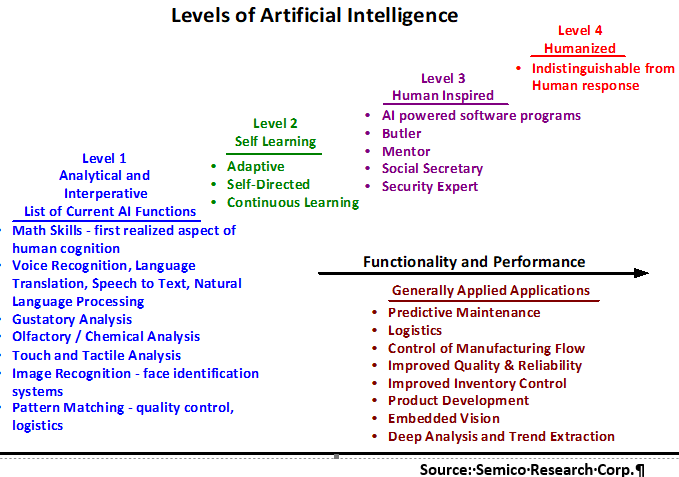
Figure 1: Different Levels of AI
Figure 1 shows the differing levels of AI functionality that are operative today and in the near future. Today, AI is very good at pattern matching. This extends to embedded vision and image recognition, language translation and speech recognition, gustatory and olfactory analysis and touch sensing and tactile analysis. Essentially, AI raises the level of intelligence in SoCs from merely having high performance levels like CPUs and GPUs to having real intelligence that provides useful data to end users.
However, given the rate at which the AI market is evolving, this current list of functions is just a starting point for SoC solutions to be considered ‘AI-enabled’ and has already evolved from here to become more powerful and to encompass many additional capabilities and features. This is an important point because a rise in the level of intelligence can be leveraged to push the silicon to perform ever-more complex operations and to provide increasing value propositions going forward. This starts to occur towards the right side of our chart – ‘Human-Inspired’ and ‘Humanized’ applications.
Requirements for Architectural Success
As architectures become more defined and algorithms become more refined, what attributes or features will be desired to deal with rising complexity and changing market requirements?
Flexibility: new architectures must be able to be algorithmically programmable and reprogrammable in response to changing conditions.
- Concurrent Operation: ability to run multiple, different types of neural nets concurrently. An example would be running algorithms for vision and audio simultaneously without compromising performance.
- Low Power: AI solutions for end-point devices must be able to function within tight power budgets, be battery operated and have long lifetimes to reduce or remove battery replacements in the field.
- Low Cost: since the majority of AI-enabled SoCs will be going into end-point devices, an efficient cost structure is a must for success.
- Scalability: given the breadth of applications where end-point devices will be deployed, the ability to scale the performance level to fit the application allows for a larger number of markets and applications to be targeted.
- Accuracy: many applications require a high degree of accuracy without incurring high power consumption. The ability to select different bit-widths for weighting parameters is highly beneficial – very memory efficient.
- Efficient Processing Architecture: Spiking Neural Networks (SNN) and Neuromorphic processing offer the ability to reduce the amount of computation needed to reach the targeted accuracy level – only react to events and not constantly burning power if no events occur – performance in real time, low latency.
- Learning Capability: with the current trend to move more computation closer to where the data is being generated, an ability to add new targets to the inference algorithm on-chip, without reliance on the Cloud, becomes a highly desired feature.
- Hybrid Architecture: some light training capability with heavy inference ability
- Fast Learning: ability to change / add new targets very quickly; <1 second
- Efficient Use of System Resources: a desirable AI solution must be able to perform adequately without requiring additional large compute resources to remain within cost, power and footprint budgets
An AI-enabled architecture that has these attributes will be a worthy competitor in the emerging market for AI-SoCs addressing a very wide range of applications and be highly valued by prospective customers and developers alike.
Where Does BrainChip Enter the Picture?
Figure 2 shows some current results of running the BrainChip Akida Neuromorphic processing architecture for various workloads using 1-4-bits for weight quantization’s compared to other architectures running 8-bit quantization’s for the same workloads.
In all cases the Akida architecture is 50% more efficient in its use of memory and bandwidth compared to other non-event domain 8-bit architectures. This is a big advantage when developers are trying to fit their solution into a very tight power budget and footprint window without giving up any performance.

Figure 2: BrainChip Power Efficient Architecture (Source: BrainChip and Semico Research Corp.)
Figure 3 shows the how BrainChip compares to other architectures running higher bit counts for accuracy. The BrainChip Akida has slightly lower accuracy results, but the comparison is between devices running 32-bit Float and the 1-4-bit weights. BrainChip is running with much smaller memory densities and much lower power budgets.
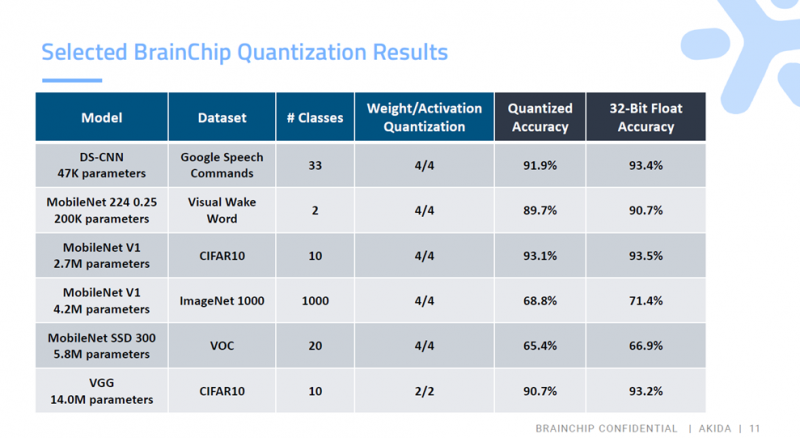
Figure 3: BrainChip Accuracy (Source: BrainChip and Semico Research Corp.)
We can see the advantage of using an SNN Neuromorphic processing architecture in these applications that are event-domain driven. By processing only the event instances in a data stream coming from the sensors, the processing workload is greatly reduced, with great positive impacts on power consumption and performance. While accuracy is slightly lower, it is not enough to compromise the overall relevance of the results to the user.
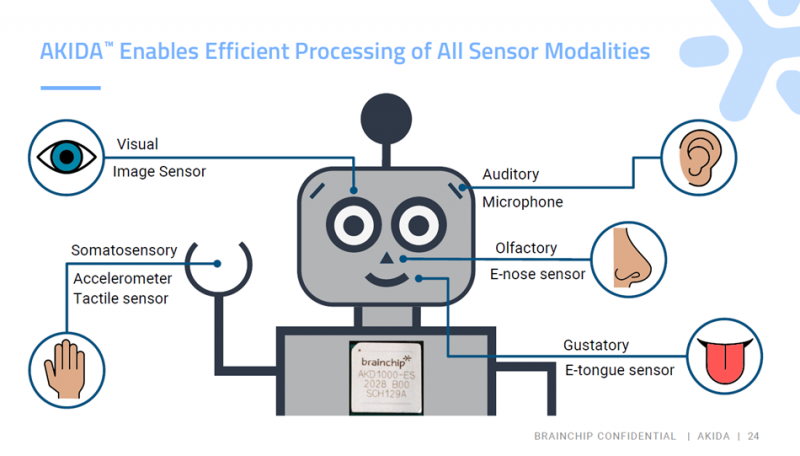
Figure 4: BrainChip Architecture Provides for Multiple User Interface Possibilities (Source: BrainChip and Semico Research Corp.)
Figure 4 shows a possible configuration of activities that would be incorporated in a mobile robotic application. Notice how all the five senses are represented in the diagram. The algorithms and neural networks necessary for this can all be run on the same BrainChip Akida Neuromorphic Processing Unit (NPU) concurrently.
This creates a set of basic capabilities – sight, sound, touch, smell, taste and speech recognition – all in one architecture, and can be used to bring the five senses to many different systems. These then become new types of user interfaces or activation points that can be deployed into many different applications.
Going back to our examples of different levels of AI in Figure 1, we can see how an architecture that is flexible and programmable can be very useful in the emerging AI market. In addition, the BrainChip architecture is scalable to be larger by adding additional processing nodes and can tackle larger workloads if desired.
New Application Models
This February, NaNose (Nano Artificial Nose) Medical and BrainChip jointly announced a new system for medical diagnosis of COVID-19. This system used an AI nano-array based on molecularly modified gold nanoparticles and a random network of single-walled carbon nanotubes paired with the Akida neuromorphic AI processor from BrainChip.
Using a non-invasive breathalyzer approach, this system collects Volatile Organic Chemicals (VOC’s) given off by a long list of diseases and passes these chemicals through the AI nano-array sensor. They used the Akida neuromorphic processor to analyze the data, giving the results almost immediately with 86% or higher accuracy.
Each of these technologies is projected to have great positive impacts on our society and economies in the near future. The marriage of metamaterials and AI in this system is an impressive first step in that direction. In addition to the great achievement of being able to detect the COVID-19 virus non-invasively, this technology pairing can also detect a range of other diseases simultaneously with similar results.
The table below shows the other diseases that are detectable by the nano-array sensor and the BrainChip neuromorphic AI processor.
| COVID-19 | Crohn’s disease (CD) |
| lung cancer (LC) | ulcerative colitis (UC) |
| colorectal cancer (CRC) | irritable bowel syndrome (IBS) |
| head and neck cancer (HNC) | idiopathic Parkinson’s (IPD) |
| ovarian cancer (OC) | atypical Parkinsonism (PDISM) |
| bladder cancer (BC) | multiple sclerosis (MS) |
| prostate cancer (PC) | pulmonary hypertension (PAH) |
| kidney cancer (KC) | Pre-eclampsia toxemia (PET) |
| gastric cancer (GC) | chronic kidney disease (CKD) |
Table 1: List of Diseases Detected by NaNose Nano-array Sensor (Source: Semico Research Corp.)
The features that attracted NaNose Medical to use the BrainChip processor were low power, high performance, low cost and the ability to function as a complete solution, removing the need for external CPUs, memory or accelerator chips. These elements are essential to the further development of this technology into a cost-effective, handheld diagnostic system that is easily deployable worldwide. This innovation points the way to other possible pairings of AI with dissimilar technologies to enter a whole host of different applications and markets where the selection of the right elements and identification of the right use-cases opens up many new areas of improvement through better sensing, testing and analysis of data.
In addition to this announcement, BrainChip also entered into an agreement with Biotome Pty Ltd. In April. Biotome is developing highly accurate antibody tests for infections. The Akida neuromorphic processor chip will be used to interpret sensor responses and to find out which responses are the most representative for antibodies that are protective. The objective of the Biotome research project is to create a handheld device that uses nanomaterial-based sensors in combination with the Akida chip that will give accurate results in seconds.
Artificial Intelligence and the SIP Market
BrainChip, along with being a device manufacturer, is also a 3rd Party Semiconductor Intellectual Property (SIP) vendor. As such they can license their neuromorphic architecture to other designers for incorporation into their own silicon solutions. In this way, BrainChip has access to other markets that are growing very quickly.
Below in Table 2 and Figure 5, Semico has included our forecast for the AI SIP market over the next five years. As this data shows, although the revenues start out small, they ramp very quickly as the semiconductor market transitions existing silicon solutions to include some level of AI functionality. In this process, the growth rates for Licensing, Royalty and Services are very high over the 5-year forecast period and are expected to stay high for the foreseeable future. Our forecast is gated somewhat by the royalties generated through unit shipments and the adoption rate of AI-enabled SoCs. This goes back to discerning the right use cases and creating the correct silicon solutions to address them. Accurately demonstrating beneficial use cases will drive adoption rates faster and generate larger royalty revenues than we are showing in this forecast.
A key enabler for the rollout of AI-SoCs is the ability to have SIP that enables as complete a solution as possible. The BrainChip Neuromorphic NPU SIP has this capability because it allows SoC designers to embed a rich set of basic capabilities. This is something that designers can quickly implement to create a whole host of new silicon solutions aimed at different applications and markets.
BrainChip is well positioned to be a leader in the emerging AI market with both their SoC solutions and their SIP.
| CAGR % | |||||||||
| Percent Growth | 2018 | 2019 | 2020 | 2021* | 2022* | 2023* | 2024* | 2025* | 20 – 25 |
| AI Licensing Revenues | 26.5% | 27.6% | 30.8% | 29.5% | 29.2% | 31.4% | 29.9% | 29.7% | 29.9% |
| AI Royalties Revenues | 114.2% | 82.5% | 37.5% | 31.2% | 31.1% | 29.4% | 32.6% | 28.3% | 30.5% |
| AI Service Revenues | 134.3% | 84.7% | 26.1% | 36.7% | 45.4% | 19.1% | 32.8% | 31.8% | 32.9% |
| Total Revenue | 55.8% | 52.3% | 33.1% | 31.0% | 32.0% | 28.9% | 31.4% | 29.4% | 30.5% |
Forecast*
Table 2: AI SIP Revenue Growth Rates (Source: Semico Research Corp.)
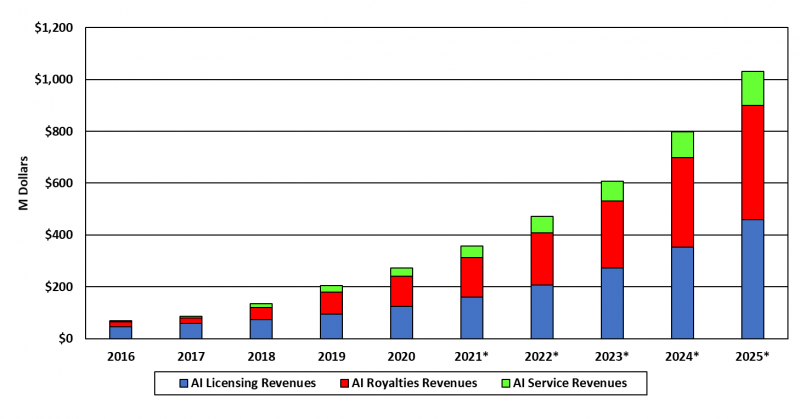
Forecast*
Figure 5: Total Worldwide IP Market Revenues for AI Applications by Type (Source: Semico Research Corp.)
What is the Real Promise of AI?
As the world saw with the introduction of the Intel 4004 microprocessor in 1971, the semiconductor industry has been evolving and growing ever since to become a prime driver of innovation in the world today. The emergence of AI is poised to be that same driving force, but with a difference.
So, what is the real promise of AI?
We are not just introducing devices with more compute power, we are introducing devices that have the same or greater computational ability, while at the same time raising the level of intelligence and making the data generated by sensors connected to these AI-enabled devices available to end users as information to be used to make better informed decisions across the length and breadth of the world.
The difference between AI and other important technological innovations is that AI allows for the creation of a set of basic capabilities that can be enhanced and embellished over time, just like the microprocessor has been. AI has started a cycle of innovation and invention that can last at least as long as the microprocessor era. In addition, the ability to marry AI functionality with other existing technologies – like the NaNose and Biotome Nano-arrays that use Carbon Nano Tubes and other new 2D metamaterials promises an even greater impact in the years ahead.
BrainChip, with their Neuromorphic NPU and its SNN, is positioned as a leader in the emerging AI industry, based on their brain-inspired technical innovation and multi-layered approach to both the current and future leading edge markets.
Rich Wawrzyniak
Senior Market Analyst, ASIC and SoC, Semico Research

